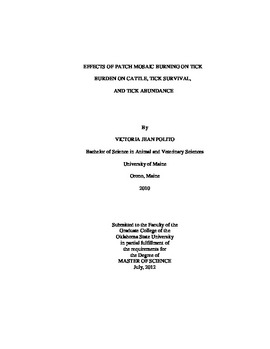| dc.contributor.advisor | Reichard, Mason V. | |
| dc.contributor.author | Polito, Victoria Jean | |
| dc.date.accessioned | 2014-04-16T03:16:02Z | |
| dc.date.available | 2014-04-16T03:16:02Z | |
| dc.date.issued | 2012-07-01 | |
| dc.identifier.uri | https://hdl.handle.net/11244/9827 | |
| dc.description.abstract | Patch mosaic burning (PMB) is a regimen that applies spatially discrete fires with different burning intervals. Along with focal grazing of ruminants, these disturbances create a shifting mosaic of vegetation. Variation in plant community structure and composition has been implicated as a means of tick control by decreasing suitable tick habitat. We hypothesize that since ticks are sensitive to fluctuations in temperature and relative humidity within microhabitats, PMB will alter the vegetation structure enough to negatively affect tick populations. To test this, we used three PMB pastures and three control pastures to study cattle infestation, microhabitat effects on tick survival, and tick abundance. Levels of infestation on cattle were determined by counting the number of ticks on cows and calves once a month from April to October. To study microhabitat differences, twenty adult, unfed Amblyomma americanum and Dermacentor variabilis were placed in enclosures twice per year in control pastures and in all subplots of PMB treated pastures. Data loggers were used to record temperature and relative humidity every 30 minutes. Tick survival was monitored weekly. For tick abundance, flannel cloth panels were dragged through control pastures and all subplots of PMB pastures to estimate abundance of ticks. A total of 13,609 ticks were recovered from cattle in 2009, 2010, and 2011. Of these, 4,028 (29.6%) were on animals kept on PMB treated pastures whereas 9,581 (70.4%) ticks were on control animals. Significant differences were observed in months of peak tick burden. Few significant differences were observed in the microhabitat study partially due to high survival of ticks. Environmental conditions measured were correlated to tick survival but were not significantly different between PMB subplots. Abundance of ticks in both PMB treated and control pastures were not significantly different. Nor were differences between PMB treated subplots. A lack of differences in these two studies could possibly be due to issues with sampling methods. These studies warrant further investigations into tick abundance and microhabitat changes of PMB. | |
| dc.format | application/pdf | |
| dc.language | en_US | |
| dc.publisher | Oklahoma State University | |
| dc.rights | Copyright is held by the author who has granted the Oklahoma State University Library the non-exclusive right to share this material in its institutional repository. Contact Digital Library Services at lib-dls@okstate.edu or 405-744-9161 for the permission policy on the use, reproduction or distribution of this material. | |
| dc.title | Effects of Patch Mosaic Burning on Tick Burden on Cattle, Tick Survival, and Tick Abundance | |
| dc.type | text | |
| dc.contributor.committeeMember | Baum, Kristen | |
| dc.contributor.committeeMember | Little, Susan E. | |
| osu.filename | Polito_okstate_0664M_12315.pdf | |
| osu.college | Center for Veterinary Health Sciences | |
| osu.accesstype | Open Access | |
| dc.description.department | Veterinary Pathobiology | |
| dc.type.genre | Thesis | |
| dc.subject.keywords | amblyomma americanum | |
| dc.subject.keywords | cattle infestation | |
| dc.subject.keywords | patch mosaic | |
